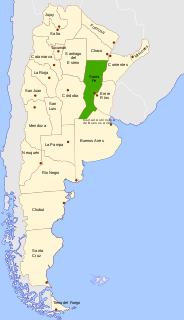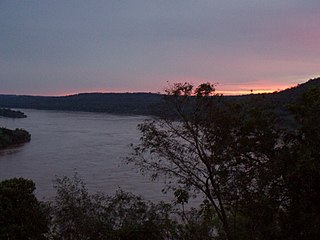The Treaty of Pilar (in Spanish, Tratado del Pilar) was a pact signed among the rulers of the Argentine provinces of Santa Fe, Entre Ríos and Buenos Aires, which is recognized as the foundation of the federal organization of the country. It was signed in the city of Pilar, Buenos Aires on 23 February 1820 by governor Estanislao López for Santa Fe, caudillo Francisco Ramírez for Entre Ríos, and provisional governor Manuel de Sarratea for Buenos Aires, after the dissolution of the national government caused by the Battle of Cepeda. A reference to it was included in the Preamble of the Argentine Constitution of 1853 as one of the "pre-existing pacts" fulfilled by it.

Argentina, officially named the Argentine Republic, is a country located mostly in the southern half of South America. Sharing the bulk of the Southern Cone with Chile to the west, the country is also bordered by Bolivia and Paraguay to the north, Brazil to the northeast, Uruguay and the South Atlantic Ocean to the east, and the Drake Passage to the south. With a mainland area of 2,780,400 km2 (1,073,500 sq mi), Argentina is the eighth-largest country in the world, the fourth largest in the Americas, and the largest Spanish-speaking nation. The sovereign state is subdivided into twenty-three provinces and one autonomous city, Buenos Aires, which is the federal capital of the nation as decided by Congress. The provinces and the capital have their own constitutions, but exist under a federal system. Argentina claims sovereignty over part of Antarctica, the Falkland Islands, and South Georgia and the South Sandwich Islands.

Argentina is subdivided into twenty-three provinces and one autonomous city, Buenos Aires, which is the federal capital of the nation as decided by Congress. The provinces and the capital have their own constitutions, but exist under a federal system.

The Province of Santa Fe is a province of Argentina, located in the center-east of the country. Neighboring provinces are from the north clockwise Chaco, Corrientes, Entre Ríos, Buenos Aires, Córdoba, and Santiago del Estero. Together with Córdoba and Entre Ríos, the province is part of the economico-political association known as the Center Region.

The treaty established national unity, the end of hostilities between the provinces, the withdrawal of military forces from Buenos Aires, a general amnesty for politically persecuted people, and the free navigability of the rivers Paraná and Uruguay by the signatories. It also called for deputies sent by them to be gathered in a congress in San Lorenzo, Santa Fe, 60 days afterwards, to decide on a federalist form of government. It noticeably excluded José Gervasio Artigas, former leader of the federalist Free Peoples' League, who had recently been defeated in the Battle of Tacuarembó (Eastern Bank, present-day Uruguay) by the Brazilian-Portuguese Empire. Artigas, who had been fighting along Santa Fe and Entre Ríos against the centralist government in Buenos Aires, denounced the pact as a treason on the part of his allies. López wrote back to him explaining that the treaty was for the common good, and wondering whether Artigas was aware of the situation in the provinces.

The Paraná River is a river in south Central South America, running through Brazil, Paraguay, and Argentina for some 4,880 kilometres (3,030 mi). It is second in length only to the Amazon River among South American rivers. The name Paraná is an abbreviation of the phrase "para rehe onáva", which comes from the Tupi language and means "like the sea". It merges first with the Paraguay River and then farther downstream with the Uruguay River to form the Río de la Plata and empties into the Atlantic Ocean.

The Uruguay River is a river in South America. It flows from north to south and forms parts of the boundaries of Brazil, Argentina, and Uruguay, separating some of the Argentine provinces of La Mesopotamia from the other two countries. It passes between the states of Santa Catarina and Rio Grande do Sul in Brazil; forms the eastern border of the provinces of Misiones, Corrientes, and Entre Ríos in Argentina; and makes up the western borders of the departments of Artigas, Salto, Paysandú, Río Negro, Soriano, and Colonia in Uruguay.

San Lorenzo is a city in the south of the province of Santa Fe, Argentina, located 23 km north of Rosario, on the western shore of the Paraná River, and forming one end of the Greater Rosario metropolitan area. It is the head town of the San Lorenzo Department, and it has about 46,000 inhabitants according to the 2010 census [INDEC].
The Treaty of Pilar was soon followed by the Treaty of Benegas, for the mutual defense of Santa Fe and Buenos Aires against the expansionist Entre Ríos and, two years later, by the Quadrilateral Treaty (including Pilar's signatories, plus Corrientes Province).
The Treaty of Benegas was a peace treaty signed by the Argentine provinces of Buenos Aires and Santa Fe on 24 November 1820.

The Republic of Entre Ríos was a short-lived republic in South America in the early nineteenth century. Comprising approximately 166,980 km2 (64,470 sq mi) of what are today the Argentine provinces of Entre Ríos and Corrientes, the country was founded in 1820 by the caudillo General Francisco Ramírez and lasted only one year. On September 28, 1821, Lucio Norberto Mansilla was elected Governor of the Province of Entre Rios, and the Republic was subsequently dissolved.
The Quadrilateral Treaty was a pact between the Argentine provinces of Buenos Aires, Santa Fe, Entre Ríos and Corrientes, signed on 25 January 1822. The treaty was intended to be an offensive-defensive pact between the signatories, in front of an attack by Luso-Brazilian invasion from the Banda Oriental, which was seen as very probable. It also wanted to establish peace after the defeat of the caudillo from Entre Ríos, Francisco Ramírez, who in 1821 had invaded Santa Fe and Córdoba Provinces, without success.











